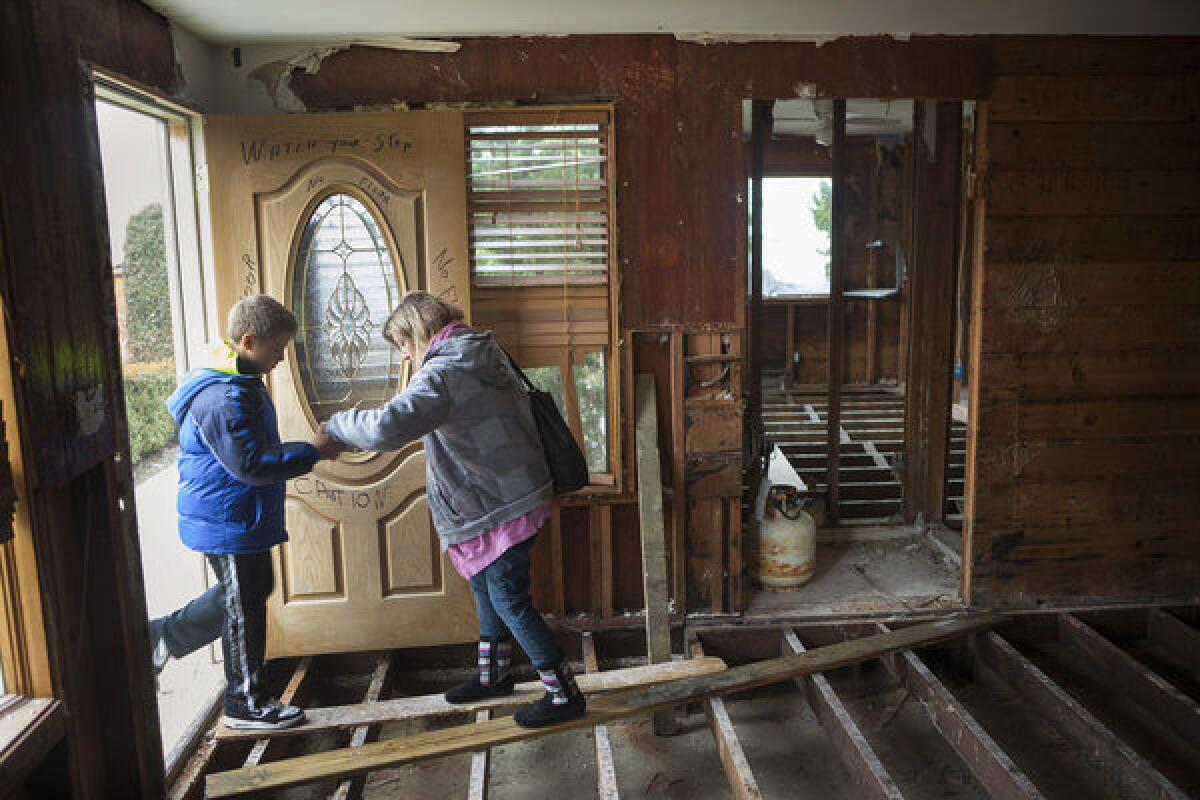In Sandy’s wake, N.J. family carries on -- ‘I’m done crying’

- Share via
POINT PLEASANT, N.J. — About a month ago, Lori Rebimbas stood inside the darkened ruins of her flooded house and wept.
When the mother of two returned last week there were no tears.
“I’m done crying,” she said.
In the days and weeks after the storm, Rebimbas, 41, felt stranded. A Federal Emergency Management Agency inspector had deemed her home uninhabitable. Her two cars had flooded. Her family had nowhere to stay, and with many along the Jersey Shore scrambling for rentals, Rebimbas was afraid she would have to move and pull her two boys out of school in Point Pleasant.
PHOTOS: Six weeks later, New Jersey still struggling
Now, a month after Superstorm Sandy slammed the Jersey Shore, there are signs of recovery for the Rebimbas family and their neighborhood about 65 miles south of New York City. But in many ways, Lori Rebimbas still feels stuck, as if progress is eluding her.
FEMA gave her $2,890 a month in temporary assistance. She found a condo to rent for $1,350, plus utilities, until May. It’s about 15 minutes away, allowing her to keep sons Christopher, 13, and Nicholas, 9, in school. But she still has a $2,000 mortgage to pay.
She has yet to receive any payments from her car insurance company for the two cars she lost. Her husband, Chris Rebimbas, 43, bought a new Ford Focus she’s afraid they can’t afford and returned to work for a local power company a week after the storm.
They stripped as much of the house on Riviera Court as they could themselves, then hired a demolition expert to finish the job including mold treatment for $7,900.
The family has $150,000 in flood insurance, but has only received $5,000. They paid the demolition company $3,500 to get started, but workers won’t finish until the family pays up.
So Rebimbas, a homemaker, has had to make peace with the wreckage.
She passed quickly through the front door last week, its carved wood scrawled with dire warnings in black marker: “Caution.” “No floor.” “Watch your step.”
The floors have been ripped up, exposing still damp wooden joists studded with rusty nail heads. Beneath them, cracks snake through the gray concrete foundation where flood waters rose four feet in the three-bedroom ranch house.
Balanced on the joists is the finished hardwood dining room table, now the only real piece of furniture that remains. Once her pride and joy, it’s been converted into a work bench with a sheet of plywood and tools on top.
Rebimbas is slight, just under 5 feet tall, and navigates the maze of wooden planks in sneakers with a cat’s ease. She was still wearing the red winter coat a neighbor gave her after the storm, which hangs on her as if she were child. She helped her younger son reach a small platform in what used to be the hallway. From there, they could see into their old rooms, as bare as the living room, dining room and kitchen.
“Nothing,” Rebimbas said, as if reminding herself. “It’s all gone.”
The smell was gone too — that briny, acidic odor of rot that set in after the storm, seeping from the carpet and exploding from opened drawers.
She stared at the bare studs and noticed a dash of color: the old light switch cover from Christopher’s bedroom, bright blue with a red, white and black lighthouse. She had decorated his room with a nautical theme, stringing fishing nets and a life preserver along walls painted with dolphins.
She tugged at the light switch cover, but it was screwed in tight. She would have to come back for it.
Rebimbas doesn’t come to the house much anymore. It feels forsaken. The demolition crew parked a dumpster in the front yard, people started tossing trash. Someone even stole the license plates from her two flooded cars. When she does stop by during the day, neighbors approach — many of them retirees, the kind of sweet people who used to watch her kids in a pinch.
“How you doing?” they shout, and she tries to sound upbeat.
“We’ve got it all gutted out inside,” she says, and they say that’s good, although it sure doesn’t feel good to her.
Contractors also stop by during the day, looking for work. She resents how they wander into her house with the familiarity of neighbors, offering advice — often unsolicited and unpleasant.
“One guy today came and said this is going to be a three-year job,” Rebimbas said.
Another walked in and just shook his head.
“Oh, no,” he said, “Too much work.”
“He could tell we’re working people,” she said. “We don’t have money to put out” and rebuild, unlike some of her neighbors, “summer people” with second homes in Florida.
She looks around the neighborhood and sees life returning to normal for those who can afford to rebuild. Contractors’ signs dot the lawns leading to her cul-de-sac, advertising restorations well underway. Another neighbor with a three-story house is still staying upstairs. Some even have Christmas lights up.
“I really wanted to be back in for summer,” Rebimbas said as she led her son away from home and back to their car, “but that’s not going to happen.”
ALSO:
Minnesota takes first step to adding moose endangered list
12-12-12: A calendar date -- and a concert -- of a lifetime
Toll in Oregon mall shooting could have been higher, sheriff says
molly.hennessy-fiske@latimes.com
More to Read
Sign up for Essential California
The most important California stories and recommendations in your inbox every morning.
You may occasionally receive promotional content from the Los Angeles Times.














